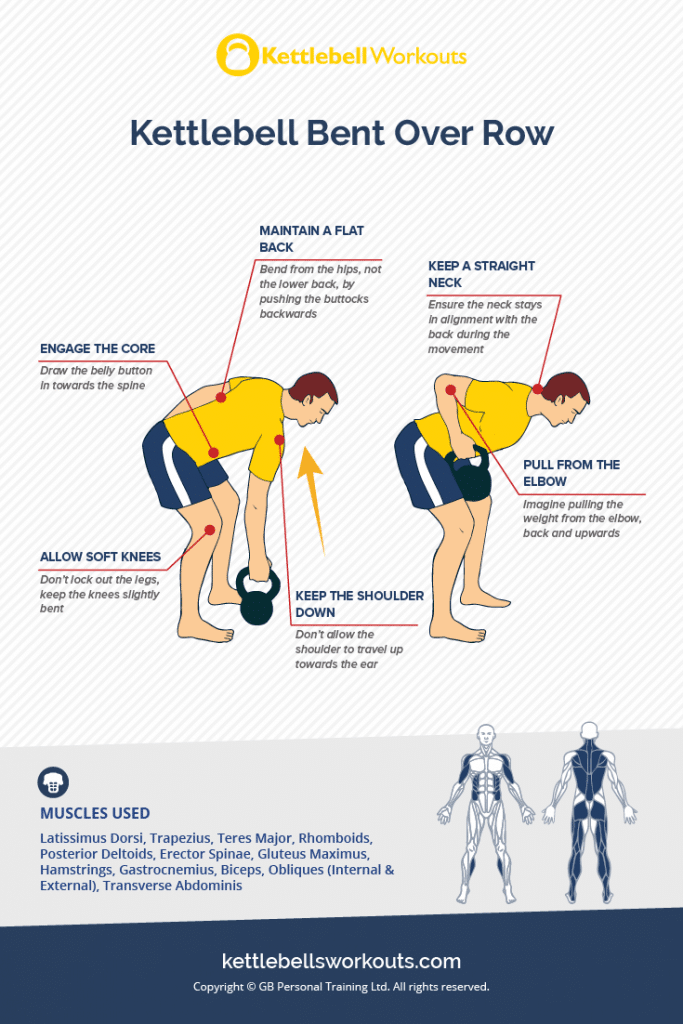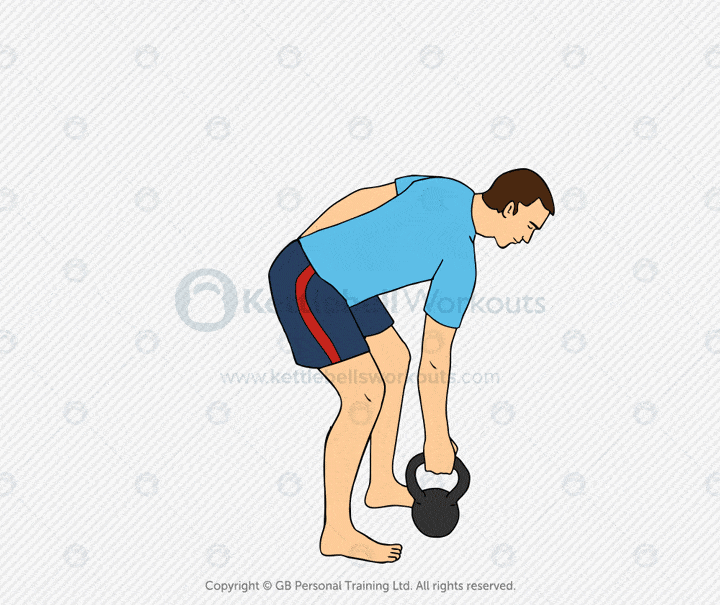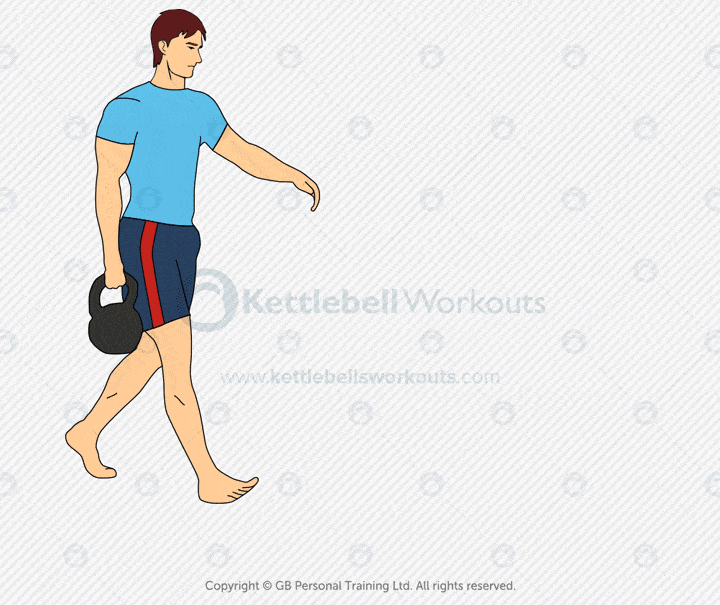Last Updated on 29 July 2025 by Greg Brookes

The kettlebell bent-over row is one of the most effective exercises for building upper back strength, shoulder stability, and core control. It’s simple in setup, but when performed with intention, it becomes a foundational pulling movement that enhances posture and total-body strength.
In nearly two decades of coaching, I’ve found this movement indispensable, both for developing strength and correcting imbalances caused by pressing-dominant training. Whether you’re a beginner or advanced lifter, the bent-over row deserves a place in your program.
What is a Kettlebell Bent-Over Row?
The kettlebell bent-over row is a unilateral pulling exercise where you hinge at the hips, brace your core, and pull a kettlebell toward your torso. It primarily trains the upper back and lats, while also challenging postural control and core stability.
Unlike barbell rows, this movement allows for a greater range of motion and helps address left-right strength discrepancies. It’s a versatile drill that fits easily into strength, hypertrophy, or metabolic conditioning circuits.

Why It Matters
Pulling strength is often the missing piece in people’s programs. Here’s why the bent-over row is essential:
Below are some of the key benefits you’ll gain from performing this exercise consistently:
- Improves posture: Strengthening the upper and mid-back muscles supports better alignment, especially for those who spend time sitting or pressing overhead.
- Balances pressing volume: Most people overtrain pushing and neglect pulling. This exercise helps restore muscular balance and prevent shoulder issues.
- Develops shoulder stability: Controlled scapular movement during the row trains the stabilising muscles of the shoulder, reducing injury risk.
- Enhances core strength and hip hinge pattern: Staying in the bent-over position engages the posterior chain and teaches trunk control.
- Transfers to real-world strength: From lifting kids or groceries to performing swings and cleans, this movement builds practical pulling strength.
These benefits collectively improve athletic performance and help correct postural deficiencies.
Muscles Worked
This movement targets several major muscle groups. Understanding which areas you’re training can help with focus and mind-muscle connection.
Here’s what gets worked:
- Latissimus Dorsi: These are the main muscles responsible for pulling the bell upward. They help widen and strengthen your back.
- Rhomboids and Trapezius: These mid-back muscles retract the shoulder blades and support scapular stability throughout the row.
- Posterior Deltoids: Assist in the upper phase of the row, providing shoulder control.
- Biceps: They bend the elbow during the pull but should not dominate the movement.
- Erector Spinae: These spinal stabilisers keep your back flat and safe in the hinge position.
- Glutes and Hamstrings: They support your body in the hip hinge, preventing collapse or lower back fatigue.
- Core: A strong brace prevents rotation and keeps the movement stable and controlled.
By training these areas simultaneously, the bent-over row becomes a comprehensive strength movement.
Step-by-Step Instructions
Here’s how to perform the kettlebell bent-over row with good form:
- Stand with your feet wider than hip-width apart and place a kettlebell between your feet.
- Hinge at the hips, keep your spine neutral, and rest your left hand on your left knee or a bench for support if needed.
- Grab the kettlebell with your right hand and engage your core.
- Pull the kettlebell towards your lower ribs, keeping your elbow close to your body.
- Squeeze your shoulder blade at the top, then lower the kettlebell with control.
- Repeat for reps, then switch sides.
Focus on keeping your torso still and avoiding any twisting or jerking motions throughout.
Watch a Video of the Kettlebell Bent Over Row
Common Mistakes to Avoid
These are the errors I often see in the gym that can reduce the effectiveness of the exercise or even cause injury:
- Rounding the back: Keep your spine neutral to protect your lower back.
- Pulling with the arm only: Engage your upper back muscles instead of relying on your biceps.
- Letting the shoulder drop forward: Focus on retracting your scapula at the top of the movement.
- Rushing through reps: Control the weight through the full range of motion, especially on the lowering phase.
- Twisting the torso: Keep your hips and shoulders square to the floor to isolate the targeted muscles.
Correcting these issues will help you get the most from the movement.
Coach’s Insight: Greg’s Take
I use the kettlebell bent-over row as both a strength builder and diagnostic tool. It tells me how well someone can hinge, stabilise, and control scapular movement.
If someone has shoulder pain or poor posture, this is often one of the first drills I prescribe. You don’t need to go heavy, you need to go controlled. Form wins over load every time.
I also love pairing rows with kettlebell presses or push-ups to balance pushing and pulling volume in a single session.
Warm-Up Drills
Before performing rows, it’s important to activate your back, core, and stabilisers. These drills will help you prepare:
- Banded pull-aparts (20 reps): Fire up the rhomboids and traps to prepare for scapular work.
- Kettlebell dead bug hold (30 seconds): Braces the core and reinforces anti-extension before hinging.
- Prone Y-T-Ws (10 reps each): Activate upper back stabilisers, perfect for shoulder prep.
- Hip hinge patterning with dowel: Teaches correct posture and pelvic control in the hinge position.
Incorporate these before your working sets to improve form and reduce injury risk.

Progressions and Regressions
The kettlebell bent-over row can be scaled up or down based on your experience and ability level. Use the options below to tailor it to your training phase:
Regression:
- Suitcase Row: Perform with both feet parallel and bell outside the foot. This is a more stable, beginner-friendly variation.
- Chest-Supported Row: Use a bench to reduce hinge demands. Great for isolating the upper back without fatigue.
Progression:
- Double Kettlebell Row: Row both bells simultaneously from a hinged position. This increases load and bilateral challenge.
- Meadow Row: Row from a landmine setup to target lats and obliques. It introduces rotation resistance and angle variety.
- Renegade Row: Add anti-rotation and core demand. Also improves shoulder stability under load.
Select your variation based on your current ability and training goal.

Programming Tips and Reps
You can use this row in different phases of your program depending on your training goal:
- For Strength: 3–4 sets of 5–8 reps per arm with a challenging load and 90 seconds rest.
- For Muscle Growth: 3–4 sets of 8–12 reps, using a controlled tempo and full range.
- For Conditioning: Include in circuits or AMRAPs with lighter weights and higher reps (12–15).
Balance it with pressing movements for a well-rounded program.
Comparison to Similar Movements
There are several row variations, but each offers unique benefits. Here’s how the kettlebell bent-over row stacks up:
Compared to the kettlebell suitcase row:
- Bent-over row increases range of motion and core demand. It also places more emphasis on scapular control.
- Suitcase row is more stable and beginner-friendly. A good entry point for building confidence.

Compared to barbell rows:
- Kettlebell variation is more joint-friendly and better for unilateral work. You can also train more freely in limited space.
Use both styles strategically to target specific goals within your programming.
Related Exercises
To continue developing your back and pulling strength, consider adding these exercises:
- Kettlebell Suitcase Row
- Renegade Row
- Kettlebell Gorilla Row
- Kettlebell Row to Clean
- Bent-Over Dumbbell Row
These variations can bring new stimulus and help round out your upper body strength.

Want More Smart Kettlebell Training?
Explore the full library of kettlebell tutorials, programs, and movement breakdowns. Build strength that transfers. Train smarter, not harder.
Strengthen your back further with all kettlebell row variations and exercises.
Frequently Asked Questions
Start with 12–16kg for men and 8–12kg for women. Progress as you build control and stability.
For strength work, 2–3 times per week is best to allow for recovery, but you can do more with much lighter loads.
Primarily the lats, traps, rhomboids, and biceps, plus your core and hamstrings to stabilise the hinge.
You may be rounding your spine or overextending. Focus on a flat back and proper hip hinge mechanics.




Comments